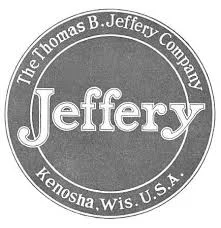www.zazzle.co.nz
The roots of American Motors Corporation go all the way back to 1887 when a Chicagoan by the name of Thomas Jeffery introduced a new bicycle called the Rambler. A decade later, Rambler bicycles were the second largest sellers in America. Entrepreneurs do not stay in business long without a good sense of market trends. Bicycles were the Big Thing of the late 1800s, but Jeffery could see another product on the horizon that threatened its popularity. He began experimenting with a new four-wheel machine called the automobile. He succeeded in building a crude contraption in 1897, but it turns out that Thomas's son Charles was the real car-guy in the family. Charles Jeffery designed a more advanced runabout which he displayed at the 1900 New York auto show.
The car, like their popular bicycles, was called the Rambler. It was so well received that the Jefferys sold their bicycle business to finance production of the automobile in Kenosha, Wisconsin. The Rambler was just the second automobile ever to be built on an assembly line. Ransom E. Olds was the first to use this process, and only his Oldsmobile sold more copies than the 1,500 Ramblers that rolled out of Kenosha in 1902. The factory would turn out cars virtually uninterrupted for the next 88 years.
The first Rambler had a 1-cylinder, 4hp engine. With a larger 2-cylinder model arriving in 1904, followed by a four in 1906, the Jefferys soon found the sweet spot in this rapidly growing auto industry. Rambler became one of the most successful cars of America's first decade on wheels and Thomas and Charles Jeffery among its leading lights.
www.romeomega.blogspot.com
In the midst of its market success tragedy struck Rambler with the passing of its elder founder. Son Charles Jeffery assumed control of the company. He began work on a more modern car powered by both four and 6-cylider engines. Debuting in 1914, they were a radical improvement over the old Rambler. So much so that Charles took the risky move of dropping the familiar and respected name and calling the new car the Jeffery.
At about the same time, Jeffery began building a four-wheel-drive truck called the Quad. Demand for the Quad was high in anticipation of America's entry into the brewing conflict in Europe. Over 13,500 cars and trunks left the Jeffrey factories in 1914.
Jeffrey quad: Precurser to the jeep (www.OffRoadVehicle.com)
By May 7, 1915, that conflict was a full-fledged world war. On that day the Jeffery Company was impacted in an acutely personal way. Charles Jeffery was traveling to Europe to get a lay of the land that his Quad trucks would soon be traversing. His passage was on the ocean liner, Lusitania. The journey ended violently off the coast of Ireland, when the ship was torpedoed by a German U-boat. The loss of nearly 1200 souls helped turn the tide toward America eventually entering the fray.
Charles was lucky enough to be among the 761 passengers who survived. But not before a four hour ordeal, drifting in the cold waters of the Irish Sea, among the debris and dead bodies. Charles was rescued but was he not the same. The Lusitania incident, combined with the still fresh memory of his father's untimely death, brought Jeffery to a decision point. Already a highly successful automaker at the ripe age of forty, he chose to retire. Within a year, the Thomas Jeffery Company had a new owner. Nash Motors was born.
Copywrite@2018 by Mal Pearson






